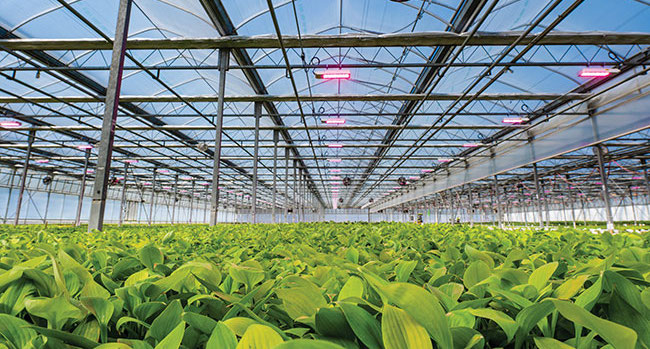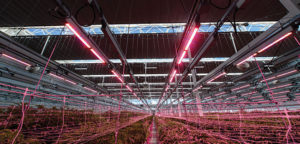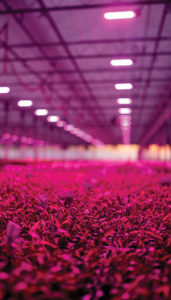
Light It Up. Black It Out.
The three standard methods to control greenhouse climate are through the management of humidity, temperature and light — the end goal being a uniform environment optimized for your specific crop. As a grower, you’re focused on carefully managing greenhouse conditions to ensure crop productivity, maximize yields and maintain a robust bottom line. But are your production tools working together synergistically or operating separately?
Supplemental lighting and use of various screening technologies are powerful tools to manage light, energy balance and climate fluctuation in the greenhouse. However, there is no one-size-fits-all approach to implementing one technology or the other, or a combination of the two. So, customizing applications based on your unique situation is the first crucial step in using these technologies in tandem. In order to best understand joint applications of LED supplemental lighting and screening systems, it helps to take a closer look at each of them separately.

Expanding Your Toolkit: LEDs
LED lighting is quickly becoming the technology of choice for growers today because LEDs enable growers to 1) customize light spectrum,
2) decrease heat production, 3) reduce energy consumption at the same light output, and 4) increase light output at the same energy cost. These benefits allow growers using LEDs to have more control over their light environment and climate conditions, which can be especially advantageous when using greenhouse screening systems.
Plants interact with light very differently than the human eye. Plants most efficiently use light in the range from blue (400 to 500 nm) to deep red (600 to 700 nm). This is the range of colors or light spectrum that provides the most PAR, or photosynthetic active radiation — it’s the range they use to grow and produce at maximum potential. HPS has a fixed output spectrum, so, unlike LEDs, spectral optimization isn’t possible.
The most efficient LEDs in the market to date are twice as efficient as HPS in converting electricity to usable light. At the same energy consumption as an HPS installation, LEDs can provide up to double the PAR light output. LEDs, therefore, produce much less heat, which of course is critical when incorporating screening into the greenhouse, as screening can impact heat retention. For example, Philips LEDs emit up to 40% less heat per watt compared to HPS lamps, and up to 67% less radiant heat — the heat that transfers to plant canopies and other surfaces. Thus, plant temperatures are lower, and plants are healthier. It’s not uncommon for crops to be 2 to 4° F cooler under LEDs compared to HPS. Overall, due to the lower radiant heat, growers can use LED lights much longer in the production season and still reduce energy consumption of the lighting installation.
Studies continue to demonstrate that LEDs provide numerous benefits to plant quality and growth due to spectral optimization and increased efficiency. Trials at Ball Horticultural Co. show that using LEDs decreased liner height on average by 1 cm when compared to HPS-grown plants, meaning that fewer PGRs are needed. A second trial at Fernlea (Ontario, Canada) showed increased light levels with LED at the same energy consumption as HPS. Using LEDs also resulted in decreased time to transplant, shorter rooting cycle and reduced production time. The difference in root mass and root intergrowth was visually noticeable in all varieties. With the increase in available light from LEDs, rooting time was decreased by two weeks, and plants were ready to sell at week 6-7 instead of week 8. If you produce 52 weeks per year, this would result in two extra turns per year.
Maximizing Your Curtains
Combining LEDs with an appropriate curtain or curtains provides an even greater level of control over greenhouse climate, whether you are trying to control daylength, shade and cool the crop, or save energy by retaining heat in the greenhouse. Modern greenhouse curtains paired with LEDs should be made of flame retardant materials for the highest level of fire safety in the greenhouse.
Multilayer blackout curtains effectively control photoperiod for short-day crops, while single-layer blackout curtains provide light abatement to meet local light pollution regulations. They accomplish this with a design incorporating a white reflective underside that also reflects and intensifies supplemental lighting, including from LEDs. A white upper side on both types of blackout curtains helps prevent heat buildup when the curtains are deployed during daylight hours.

Light management in the greenhouse is critical for optimal crop growth. Crops must receive appropriate PARSUM or DLI (daily light integral) during each week of their growth cycle, as well as receive appropriate instantaneous light levels that are not too high. Specifically, targeting an appropriate light intensity for the crop and ensuring proper light uniformity (greater than 80%) across the greenhouse are critical for year-round success.
Greenhouse curtains providing shade are useful for this during the summer months in mid and high latitude, and throughout the year in lower latitudes. Modern Svensson curtains don’t just block light; they reflect light away to help maintain cooler temperature. They also provide high-grade light diffusion — evenly spreading light across the crop below them. These curtains help maximize greenhouse light deeper throughout the crop canopy to increase production, lessen the risk of tip and leaf burn, and strengthen plants. Overall, modern light diffusion curtains combine well with modern LEDs for even greenhouse climate — modern LEDs help to reduce hot spots, and inconsistencies in temperature and light level in the greenhouse.
Shade curtains should be selected with the type of crop (and its light and temperature requirements), physical location of the greenhouse, and type of greenhouse cover in mind. All greenhouse structures and cover materials block some light. Glass greenhouses can reduce light by 30% before reaching crop level, greenhouses of other materials such as polycarbonate can reduce light 55% relative to the outdoors. This should be taken into account when selecting the shade level of your greenhouse curtains, as well as in planning out your supplemental lighting with LEDs.
Winter conditions matter a great deal as well, as DLI decreases greatly in the winter months in mid and high latitudes. In the northern U.S. it is not uncommon for outdoor DLI to drop to 6 to 10 moles/day and interior DLI to 2 to 4 moles/day. Growers in these regions who need to grow an ornamental or vegetable crop throughout the winter months may consider a transparent energy-saving curtain as well. These curtains retain heat underneath them to conserve the energy used in greenhouse heating, and their transparent structure allows them to be deployed during the winter days without sacrificing light. Indeed, these curtains pair well with LEDs for winter production.
Better Together
LEDs optimize screen systems and vice versa, allowing growers to assess and adjust the whole climate, rather than impacting different parts of both the plant and the greenhouse in different ways. When you can’t gap screens, for example, you risk heat and humidity buildup. Though today’s high-quality breathable fabrics allow exceptional humidity control (for example, Svensson’s knitted screens wick water across their yarns, helping prevent humidity level extremes and condensation formation on the screens) climate challenges still exist. That effect is much more manageable with the cooler LED system pulling less heat into the environment, for less strain on the system. LEDs allow you to reduce energy usage and heat emissions while increasing light levels.
Effectively tailoring your curtains to the right LED lighting gives you the power to separate heat and light to stabilize the greenhouse climate and deliver maximum uniformity year-round. You’ll see the results in shorter rooting time, increased plant quality, higher turns and increased productivity.
All signs point to the value of integrating your supplemental lighting and screening strategies and products. Using the right screening products and LED lighting recipes together gives you new levels of control to effectively manage greenhouse climate, optimize crop cultivation, and ensure compliance with local light pollution ordinances — all without compromising your production goals or your bottom line.









 Video Library
Video Library 


















